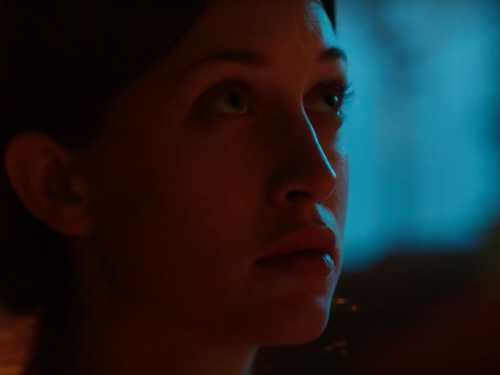
Save this storySave this storySave this storySave this story
Half of life is spent dealing with details: the numbers, the paperwork, the dozens of discussions upon which any shared activity, professional or private, is based. (The other half of life is dealing with the results.) Many filmmakers leave such practicalities behind, feeding escapist desires with alluring realms of fantasy. The better ones understand that those details aren’t the antithesis of drama but its essence. Michael Mann has long been a director of details—so much so that they have often sat heavily and portentously in the action, plot points made flesh. His new film, “Ferrari,” is similar but different; it’s the kind of purified, rarefied film that major filmmakers make late in their careers, in which they get to the heart of the matter plainly and present their subjects unadorned and unamplified. In “Ferrari,” Mann’s meticulous attention to the details conveys how deeply he cares about the subject. The story seems more important to him than the manner of telling it or the application of a style, and the story’s details, far from being mere signposts for the plot, emerge as the very essence of emotion, not least because of the stark force of their very nature: they’re a matter of life and death.
The action begins, on a bright early morning, with a delicious bit of indirection: a silver-haired man (played by Adam Driver) slips out of bed quietly, so as not to wake a sleeping younger woman (Shailene Woodley) who could be his wife, given that, on the way out, he stops by another bedroom and tucks in a sleeping boy (Giuseppe Festinese). Meanwhile, the phone rings for him in another house, where another woman, Laura (Penélope Cruz), answers and makes excuses for his absence. When he comes in, she greets him with a pistol. He is Enzo Ferrari, Laura is his wife, and he has just violated a long-standing ground rule: she won’t question his philandering so long as he is home in time for morning coffee, in order to maintain appearances in front of the domestic staff. Now he has stayed overnight with his longtime lover, Lina Lardi, and their son, Piero, whose existence Laura is unaware of. From the start, Mann sets up the question of what makes a family, and the action suggests an answer: being ready to kill for the person you’re ready to kill.
“Ferrari” is a death-haunted movie even aside from the dangers of auto racing. Enzo lost his father and his brother during the First World War; Dino, his son with Laura, died in 1956, at the age of twenty-four, of muscular dystrophy, and they visit Dino’s crypt every day, with Enzo confiding in him out loud as if to a ghostly presence. Enzo’s field of endeavor is a mortal one; his career is shadowed by traumatic deaths. As a young man (seen both in actual documentary photographs and in Driver’s incarnation), Enzo Ferrari was a race-car driver; just before Dino was born, he switched to organizing a team of racers. With Laura, Enzo founded the car company bearing his family name in 1947, and Enzo continued to hire drivers and pursue victory despite the knowledge—the experience—that drivers will die. Even in 1957, he’s still tormented by the death of two close friends who drove for him in a 1933 race, yet he’s unrelenting in his pursuit of racing victories and, especially, in his competition with Maserati.
That pursuit of victory is both a personal passion and a desperate practical necessity. The crux of the story is business: Ferrari (the company) is threatened with bankruptcy because Enzo is spending too much on the racing division. In order to sell more retail cars, the company needs the publicity from winning a major race: the Mille Miglia, a thousand-mile daylong race from Brescia to Rome and back. In order to negotiate the necessary outside investment from a larger automaker (such as Fiat or Ford), Enzo needs full control of the company, some of which is legally in the hands of Laura. But her commitment to Enzo and the company is sorely tested by his affair; in her anger, she may be willing to destroy the business in order to destroy the man.
Working with a script by Troy Kennedy Martin, based on a biography of Enzo Ferrari by Brock Yates, Mann does far more than weave the particulars of these plans and negotiations through the action; they are the action. The linchpin of the drama is, of all things, a check—whether or not it’s signed, whether or not it’s cashed. The crux of the tragedy is a trivial element of roadwork. The cause for which lives are risked is a matter of mere seconds; shaving off these few seconds from a track record is a goal that Enzo pursues with a blank determination.
Mann’s attention to detail finds an echo in Enzo’s, which is what makes the film seem like a personal statement, rather than just a beautifully executed bio-pic. At one moment, the driver Piero Taruffi (Patrick Dempsey) half-jokingly asks for an ashtray in his racing car; much later, Enzo emphasizes to his pit crew that they must take care not to splash gasoline on drivers—especially the smoker Taruffi. There’s a thrill in how surely yet subtly Mann conveys Enzo’s total command of every aspect of his operation, linking a moment of banter to a consideration of mortal danger. Enzo knows that danger can come from anywhere—not just a crash but also a seemingly trivial splash—and Mann keeps his audience aware that these men are used to living with death as a constant possibility.
When, on the night of a race, the drivers leave notes in their hotel rooms for their significant others, the gesture is all the more affecting for how astonishingly ordinary it seems.
“Ferrari” displays a near-obsession with the material aspect of racing—for that matter, the physicality of driving anywhere. Whether at racetracks or simply around town, car scenes feature recurrent, sharply edited closeups of hands on gearshifts and feet on clutches. (These details echo similar images in another great movie of adultery and jealousy, François Truffaut’s “The Soft Skin,” from 1964.) Mann gets away from conventional shots of race cars (such as the merely sensation-stoking, tire-level ones of “Ford v. Ferrari”) to show what drivers see. Filming over their shoulders or even straight through the windshield, he shows the road ahead as an inscrutable stretch of menacing uncertainty and shows racetracks on which implacable curves suddenly loom.
When a driver dies doing a test run, Enzo recruits a replacement—an ambitious young driver named Alfonso de Portago (Gabriel Leone)—as casually as if he were offering him a coffee. But Enzo is soon dissatisfied and, in a dining-room speech of terrifying bluntness, berates a gathering of his drivers for what he sees as their complacency. He says that they lack the “brutal determination to win,” whereas their rivals are ready to win or die trying. And this, he says, is the racer’s life—“our deadly passion, our terrible joy.” Easy for Enzo to say, one might think, from his office or the hotel bar from which he follows a race, and, indeed, Laura reproaches him when she finds him oddly calm after a driver’s death. His answer is at the core of the character and of the film: his choice, early on, was “Enzo, build a wall”—separating his behavior from his emotions—or “Enzo, go do something else.” The maintenance of that wall, and the cultivation of the side of it that faces outward in Enzo’s professional and domestic life alike, comes at an immense price; Driver’s tensely majestic performance conveys the turmoil and the conflict that prevail on its other, private side, the mighty effort that it takes to keep sufficient order within, so as not to risk it tumbling down.
As Enzo, Driver is trim and erect, moving with an elegant sense of swing that Mann matches with a curvaceously mobile camera tracing brisk, suave arcs around him. Driver sublimates his hulking physicality into a taut aerodynamic precision; the air around Enzo parts with a discernible whoosh, and heads turn. It’s breathtaking to see Enzo maneuver: he’s addressed as “Commendatore” and lives up to the grandiosity, providing not just an intrepid public face for the company but also, for his drivers and engineers, both a discerning analyst and an effective motivator. He always sees what needs tweaking and says the right thing at the right time both to tune the equipment to perfection and to put the drivers—each of whom needs something different from him, in substance and tone—in the optimally competitive frame of mind.
Being intensely aware of appearances, Enzo is also intensely focussed on executing ruses and getting away with deceptions. Witness, in that first sequence, the elegance with which he sneaks off from Lina in the morning, rolling his car silently down the driveway and not revving the engine until out of earshot. (Oddly, another of the season’s good movies, “The Iron Claw,” also features characters who perform a similar maneuver.) Notably, Enzo is quickly depicted as a major public figure who’s recognized and applauded in the street by a small crowd that’s welcoming an arriving opera troupe. His public image is grossly tarnished by death—not only of drivers but also of spectators in the wrong place at the wrong time—and his effort to control and burnish that image with some clandestine maneuvering proves to be (no spoilers) a major dramatic motive.
Maintaining appearances is a part of Laura’s business and life, too. In this season of movies in which famous men are seen in close collaboration with their less-famous wives (“Maestro,” “Napoleon”), “Ferrari” stands out both for its meticulous specificity on business matters and for its emphasis on Laura’s audacious and analytical grasp of them. There are plenty of legal issues and fiduciary fine points at the core of the action, and Laura is even more attentive to them than Enzo is. Tellingly, it’s in the course of managing banking matters that Laura discovers the extent of Enzo’s romantic deceptions; an accounting concern precipitates a marital crisis that menaces the whole company. Cruz, ferociously focussed and lethally determined even (or especially) in frozen stillness, nonetheless portrays Laura as a character with fewer walls than Enzo. Unlike him, Laura knows how to fight, to unleash torrents of invective with the unhinged sincerity of authentic passion. It gives her an edge of danger, and that edge is as effective in business as it is in marriage.
When a relationship has no boundaries between the personal and the professional, it isn’t just the business that’s at risk. Just as crashes can harm spectators, the marital conflict also involves an utterly innocent party: Piero, Enzo’s son with Lina. (The strangest outcome of the movie is its open-endedness or, rather, the hints and allusions with which the story of father and son is left unresolved.) Yet Piero is the secret heart of the movie, and his presence gives Enzo—and Mann—a signature moment: a breathtaking scene of paternal bonding that’s centered on a lesson about the fluid dynamics of gasoline in engines. When young Piero, who’s about twelve, enthuses over the beauty of a diagram, Enzo conveys a “secret” to him: “In all life, when a thing works better, usually it is more beautiful to the eye.” In disclosing the secret of engineering, Mann also offers a passionate and personal word on the secret of the cinema itself. ♦
Sourse: newyorker.com






